- Industrial LCD display
-
Industrial Products
- DC Servo Drive
- AC Servo Drive
- other
- Heidelberg
- FANUC
- IFM
- Meter
- CCD
- Membrane Keypad
- Film
- YOKOGAWA Module
- Card
- ABB
- MITSUBISHI
- FANUC
- KEYENCE
- BECKHOFF
- Honeywell
- HOLLYSYS
- FUJI servo drives
- HP
- solenoid valve
- thermostat
- Siemens adapter
- color oscilloscope
- Fujitsu connector
- CHELIC
- SMC
- CISCO Module
- INTEL
- Key board
- FAIRCHILD
- Motherboard
- Board
- Bearing
- other
- Control Panel
- Contactor
- Circuit
- OMRON
- Relay
- Controller
- Photoelectric Switch
- Photoelectric Sensor
- Original
- Fan
- Motor Driver
- Limit Switch
- Amplifier
- power supply
- LENZE
- Cable
- Encoder
- Sensor
- Transformer
- Fiber Optic Sensor
- Protection Relay
- Temperature Controller
- Proximity Switch
- Switch Sensor
- Siemens
- Industrial board
- HMI Touch Glass
-
HMI Full Machine Whole unit
- OMRON HMI Touch Panel
- Siemens HMI Touch Panel
- Mitsubishi HMI Touch Panel
- Allen-Bradley automation HMI Touch Panel
- DELTA HMI Touch Panel
- EVIEW DELTA HMI Touch Panel
- KINCO DELTA HMI Touch Panel
- HITECH HMI Touch Panel
- WEINTECK HMI Touch Panel
- TECVIEW HMI Touch Panel
- WEINVIEW HMI Touch Panel
- PRO-FACE HMI Touch Panel
- SIMATIC HMI Touch Panel
- AMPIRE HMI Touch Panel
- HEIDELBERG HMI Touch Panel
- PANASONIC HMI Touch Panel
- PATLITE HMI Touch Panel
- KYOCERA HMI Touch Panel
- KEYENCE HMI Touch Panel
- WEINVIEW HMI Touch Panel
- HITECH HMI Touch Panel
- FUJI HMI Touch Panel
- HAKKO HMI Touch Panel
- SCHNEIDER HMI Touch Panel
- SAMKOON touch panel
- other
- Module
- lcd inverter
- Membrane Keypad Switch
- Winni Touch Screens
- Frequency Inverter
- Servo Motor
- PLC
|
If an LCD monitor is trying to display black then the colour filter will be positioned such that as little light as possible (of any colour) from the backlight will get through. Most LCD monitors will do a reasonable job at this but the filter isn’t perfect and so the blacks may not appear as deep as they should. A definite strength of the VA panel is its efficiency at blocking light from the backlight when it’s not wanted. This gives deeper blacks and higher contrast ratios of around 2000:1 – 5000:1 with ‘dynamic contrast’ modes disabled – several times higher than that of the other LCD technologies. They are also less susceptible to ‘bleed’ or ‘clouding’ towards the edges of the screen which can make such screens good candidates for movie lovers and nice to use for general purpose work. Another key advantage of VA is the improved viewing angles and colour reproduction compared to TN. The shift in colour across the screen and ‘off angle’ is less pronounced whilst shades can be produced with greater precision. In this respect they are better candidates for ‘colour critical work’ but they are not as strong in this area as the IPS or PLS technologies explored subsequently. There is generally a weakening of saturation when comparing a shade in the centre of the screen vs. that same shade towards the edges or bottom of the screen, from a normal viewing angle. There is also a shift in gamma that is most noticeable on greys but can also be observed on other shades, with said shade appearing to lighten or darken quite readily with even slight head movement.
It isn’t cost that has traditionally been the main weakness of the VA panel as they are typically fairly affordable with a good modern range available from companies such as Philips, Iiyama, BenQ and Samsung. The real weakness comes in their relatively low level of responsiveness with pixels transitioning from one state to another relatively slowly – leading to more pronounced blurring during fast motion. In some severe cases things can appear to ‘smear’ into a smoke-like trail as demonstrated in the video below, taken on a BenQ EW2430. Some of the modern VA panel types used on PC monitors include MVA (Multi-domain Vertical Alignment), AMVA (Advanced MVA) or AMVA+ (AMVA with slightly enhanced viewing angles). Recent AMVA(+) models generally use effective pixel overdrive and don’t suffer from these extensive ‘smoke-like’ trails. They are actually on par with modern IPS models during some pixel transitions. Other pixel transitions, typically between light colours and dark bold colours, are still relatively slow – but not to the extent demonstrated in the video above. We were also rather impressed by the performance of the Samsung S34E790C, which generally performed better than one of its IPS counterparts (the Dell U3415W) when it came to responsiveness.
Panel manufacturer AU Optronics (AUO) have created a 35″ ‘UltraWide’ VA panel with 144Hz refresh rate, something used in the likes of the BenQ XR3501 and Acer Z35. Despite the high refresh rate, some pixel transitions were again notably sluggish. Both AUO and Samsung are producing various other 100Hz+ VA panels as well. Sharp have some specialist MVA panels used on a few models including the FG2421 that natively support 120Hz. Doubling the refresh rate alone is only so good if the pixels can’t really keep up, though. To help overcome these limitations monitors using the Sharp panel employ a strobe backlight combined with frame rate doubling (something called ‘Turbo240’) to essentially hide a lot of the pixel transition behaviour and reduce eye-tracking motion blur. These concepts are discussed in detail in our dedicated responsiveness article. |























